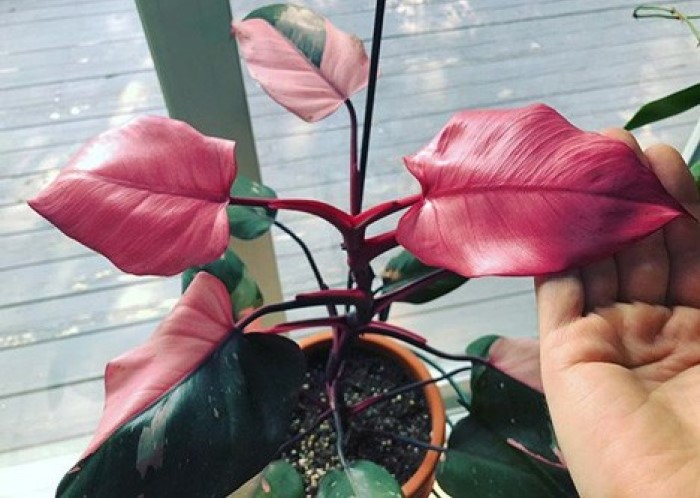
It is a highly sought-after pink princess philodendron (Philodendron erubescens pink princess’), and it is a very popular plant. The pink princess is a unique plant, with its deep green heart-shaped leaves and bubblegum pink variegation. It can be confused with the Philodendron pink Congo.
However, the variegation that occurs in the pink princess is stable and is due to natural processes. The pink congo variegation, on the other hand, is usually caused by chemicals that are injected into leaves. Usually, they revert to green within a few months.
How to care for your pink princess Philodendron is key to maintaining its beautiful pink color. It is easy to care for, like many other plants in the Philodendron genus.
Pink Princess Philodendron: How to Care and Grow Your Pink Princess
Pink Princess Philodendron Care
The pink princess philodendron, a tropical aroid belonging to the Araceae family, is native to Columbia. This colorful plant, despite its price tag, is easy to maintain. To maximize the leaf variegation, there are some key points to remember. The pink princess can produce flowers, but the spathes are small compared to the plant’s foliage. It is very rare for them indoors to flower.
Soil
The pink princess philodendron is an aroid and needs well-drained soil with high organic matter. The pink princess will love a mixture of standard potting soil, perlite, and orchid bark.
Water
Let the top half of your soil dry between waterings, then water well. Root rot is a serious problem for pink princesses if they sit in wet soil. It’s easier to overwater your pink princess Philodendron than it is to water it properly. If you aren’t sure if it needs water, wait until the next day.
Light
The most important thing that will influence the amount of variegation your pink princess philodendron will experience is enough light. You should choose a place that gets several hours of indirect, bright light. The pink princess philodendron can be grown indoors and will tolerate some direct sunlight for a few hours.
This may increase its ability to variegate. A grow light is recommended for this plant if you don’t have enough light. Lack of enough light will cause the pink princesses’ leaves to turn green quickly, and they will soon lose their stunning color.
Fertilizer
Regular monthly feedings of a balanced liquid fertilizer are beneficial for the pink princess philodendron’s growing season (spring/summer). Your plant will go dormant in the fall so you should stop fertilizing it.
Humidity and Temperature
The pink princess Philodendron thrives in humid, warm conditions. However, they can be grown in normal household temperatures and humidity. Your plant should be kept between 65 and 79°F (18 to 26°C) and not exposed to temperatures below 60°F (15 degrees Celsius).
Philodendron Pink Princess Care Guide
Propagating Pink Princess Philodendron
The pink princess, like most philodendrons, can be propagated easily by stem cuttings. This will allow you to create a new plant for a friend or to help encourage variegation. In just a few steps, you can make stem cuttings to propagate your pink princess Philodendron.
- First, decide where to cut the stem. Your cutting should have 2 to3 leaves and 2 or 3 exposed nodes at its base.
- Use a pair of sterilized pruning shears, or scissors to cut the stem.
- Take out the bottom leaves of your cutting and leave only 2 or 3 leaves at its top.
- Allow the cutting to rest for 12-24 hours so that the edge can become callus.
- After the edge is calloused, soak the cutting in water. Place it in direct sunlight. Make sure that all exposed edges of the cutting remain submerged in water.
- You should see new roots starting to sprout within 2-3 weeks.
- After the roots reach at least 1″ in length, the cutting can then be returned to the soil. Use a well-draining, potting mix and water thoroughly.
How I Grew My Pink Princess: Pink Princess Philodendron Tips
Common Pests & Plant Diseases
The pink princess Philodendron is vulnerable to many common houseplant diseases and pests. Common pests include scale, mealybugs, and spider mites. Root rot is caused by overwatering and rust spot is caused by fungus infections.
Pink Princess Philodendron: Propagation, Air Layering & Plant Care Tips
Problems Common to Pink Princess Philodendron
Pink princess philodendrons can be cared for with minimal effort. These tropical plants are susceptible to problems such as poor watering, low humidity, and lack of light.
Browning Edges
The browning of the edges of pink princess philodendron leaves is usually caused by a lack of humidity, which causes them to dry out. It is impossible to reverse the damage done once it has occurred. However, you can increase the humidity around the plant to prevent further browning.
Browning Variegation
Brown spots are not something you want on your pink variegation. However, this is possible if your plant is exposed to too much light. Large burn marks can result from delicate pink spots appearing on leaves that are exposed to harsh lighting. This can sometimes be caused by a lack of humidity, as previously mentioned.
FAQ
Why is the pink princess Philodendron so costly?
Due to their beautiful foliage, these tropical plants are extremely popular and it is difficult for growers to keep up with the demand. These plants can be difficult to grow from seeds because of their variegation, which is caused by mutation. Even though pink princesses can be cared for quite easily, this has led to sky-high prices.
Why my plant is losing its pink color?
It is most likely because there is not enough light. To promote strong variegation, ensure that your plant gets bright indirect light.
Why my plant is becoming leggy?
Leggy growth indicates that your plant doesn’t get enough sunlight. This can cause the leaves to seek more light. To prevent leggy growth, move your plant to a brighter area.
